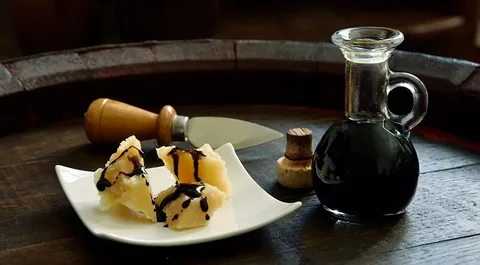Balsamic vinegar of Modena is a true gem of Italian culinary tradition, loved worldwide for its unmistakable flavor and versatility. This condiment, which originated centuries ago in the heart of Emilia-Romagna, is a cultural heritage that tells stories of ancient families, passed-down traditions, and a unique territory.
But what makes balsamic vinegar so special? The answer lies in a perfect balance between fidelity to the artisanal methods of the past and openness to technological innovations that enhance its quality and expand its possibilities. Every drop encapsulates the result of a long process of care and dedication, from the selection of grapes to the expert maturation in precious wooden barrels.
Table of Contents
The historical origins of balsamic vinegar of Modena
The history of balsamic vinegar of Modena dates back to Roman times, when it was used both as a condiment and a natural remedy. Historical documents show that cooked must, the base for balsamic vinegar production, was already appreciated for its preservative properties and unique flavor. Its fame grew in the Middle Ages, when it became a precious commodity and a symbol of prestige among noble families, who regarded it as a prized gift to offer distinguished guests and the most influential European courts.
During the Renaissance, balsamic vinegar gained prominence in the kitchens of aristocratic families, who carefully guarded their recipes. Vinegar cellars, often integrated into noble estates, were considered family treasures, and the barrels where the vinegar matured were passed down from generation to generation. Even today, historic vinegar cellars, such as Acetaia Leonardi, preserve these ancient traditions, maintaining a deep connection with the past while the product continues to be a symbol of Italian culture and gastronomy.
The traditional production process
The production of traditional balsamic vinegar of Modena DOP follows strict guidelines that ensure the quality and authenticity of the final product. Selected grapes, primarily Trebbiano and Lambrusco, are harvested at the right level of ripeness and slowly cooked to obtain must, a base rich in natural sugars.
This must, then, is naturally fermented, beginning the long aging process in a series of barrels made of precious woods such as oak, cherry, chestnut, and mulberry. During this period, which can last a minimum of 12 years and up to over 25 years for traditional balsamic vinegar, the product develops a complex flavor and a characteristic sweet and tangy aroma.
A key aspect of this production is the “refill” method, which involves transferring vinegar from larger barrels to smaller ones, allowing the product to acquire unique nuances from each type of wood. Acetaia Leonardi, one of the most renowned vinegar cellars in the region, exemplifies how these traditional techniques are meticulously preserved. Thanks to their expertise and dedication, the vinegar not only respects methods passed down through generations but also stands as a symbol of authentic Modenese excellence.
Innovation in the production of balsamic vinegar of Modena
In recent years, the production of balsamic vinegar of Modena has embraced innovative technologies that enhance production processes without compromising quality. Modern monitoring systems, such as digital tools for fermentation and aging, ensure maximum food safety and optimize timing while adhering to strict production standards. These technologies allow real-time monitoring of essential parameters such as acidity, density, and maturation levels, guaranteeing a final product that meets the highest expectations.
In addition to these innovations, Modenese vinegar producers have introduced sustainable methods to reduce the environmental impact of production. For instance, the use of renewable energy and intelligent resource management technologies optimize processes without sacrificing artisanal quality. At the same time, advanced packaging techniques ensure the perfect preservation of the product and facilitate its global distribution, making balsamic vinegar of Modena accessible to an increasingly broad audience while maintaining its strong connection to tradition.
